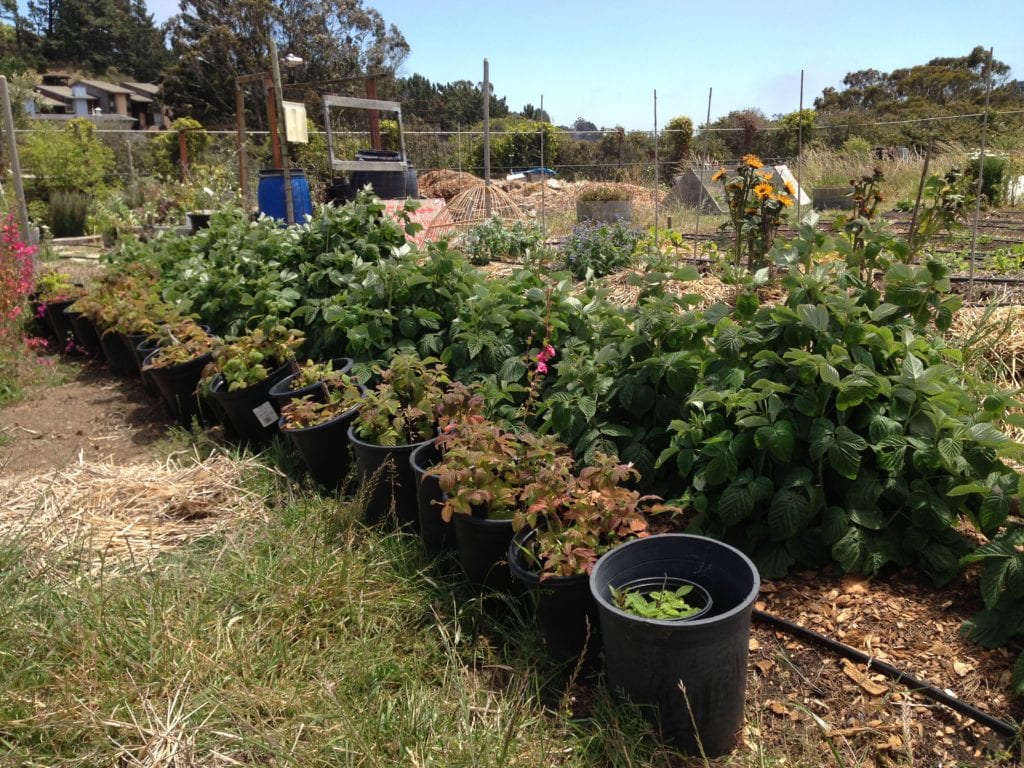
Story and photos by Murray Schneider
Glen Park now has its own farm atop one of the highest hills in San Francisco. The one-quarter acre green space is perched on the cusp of Glen Canyon and bookended by Twin Peaks and Mount Davidson. The farm is tucked away on the grounds of the former J. Eugene McAteer High School, only yards from the source of Islais Creek.
Since 2010 the Academy of Arts and Sciences and the Ruth Asawa School of the Arts have partnered with the non-profit Ecology Center San Francisco and established an outdoor learning space dedicated to organic and sustainable farming.
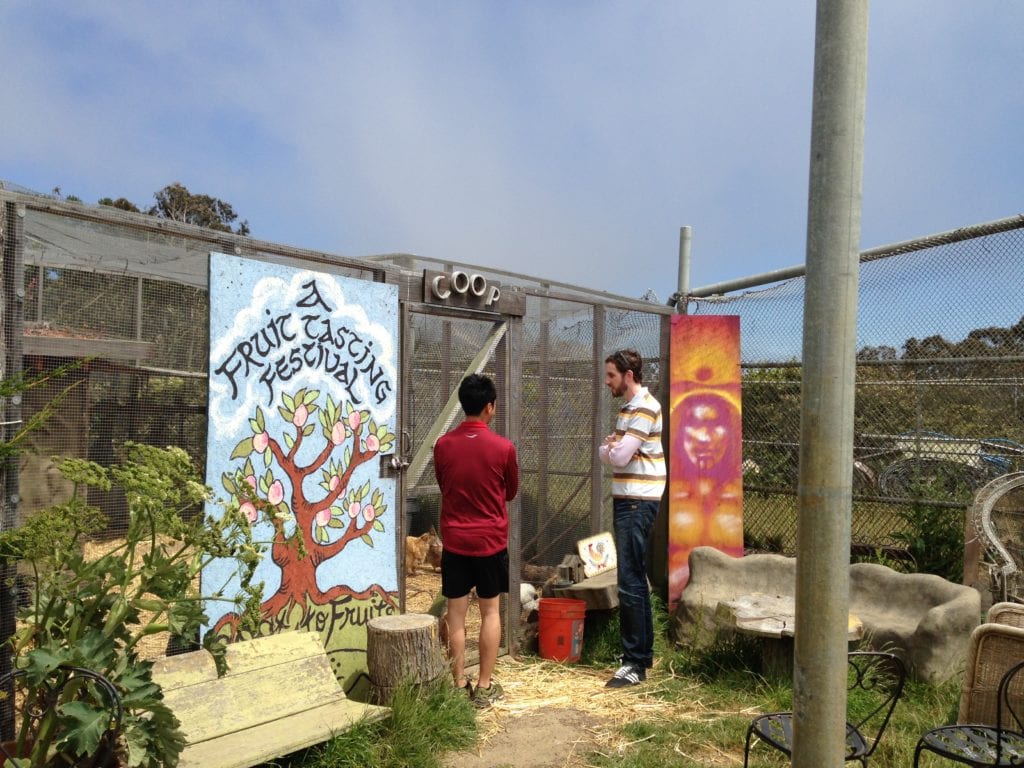
The School Farm Program offers teens an experiential, project-based educational program, and it has flourished for three years due to collaboration between the SFUSD and ECOSF, which is staffed by three non-salaried volunteers.
Nestled on a postage stamp-corner of the campus football field, the agrarian project boasts rows of student grown organic vegetables, an earthen chicken coop that houses 22 egg-laying hens, a 32-inch cob oven, habitat-friendly California native plants, a rainwater catchment system, on-site-compost production and outdoor classrooms.
Could there be a facility any more consistent with eco-friendly San Francisco?

Neither Tom Dallman, an Academy biology teacher, and Davin Wentworth-Thrasher, an ECOSF team member, believe so. On a recent afternoon, both men wandered the farm, only a few feet from a trail sculpted by Academy and SOTA urban homesteaders, which will eventually hook up with paths in Glen Canyon that are overseen by San Francisco Recreation and Park’s Natural Area Program.
“We’re making San Francisco our classroom,” said Dallman, who has been teaching at the high school for 10 years. “We’re building this beautiful space into our curriculum.”
“The kids see the natural setting of the canyon and feel in touch with nature,” said Wentworth-Thrasher, a San Francisco native and Lowell High School graduate, who completes a Civil Engineering degree at San Francisco State University this fall.
He unlocked the door to the farm chicken coop. Ranging among the numerous hens pecking for food stood a lithe and vigilant rooster. “That’s Jesse James,” said Tori Jacobs, another ECOSF staff member, a native Minnesotan who until recently lived on a Half Moon Bay ranch were she raised 80 hens.
“We take pride in offering environmental education,” said Wentworth-Thrasher. “These hens lay dozens of eggs.”
“During the spring and summer when they’re most productive we can get from one or two eggs,” said Jacobs. “Each hen has a life expectancy of about 12 years and by five years old their egg production slows.”
Marcus Wong, a volunteer, placed day-old challah pieces on the ground.
A flock of hens gathered around the bread, which is donated by Arizmendi Bakery on Ninth Avenue in the Inner Sunset.
“Arizmendi is generous,” said Jacobs, who’d arrived late because she’d just arrived from a meeting with Mollie Stone on Portola Drive. Under discussion was partnering with the grocery store.
“We normally buy a chick starter laying blend in pellets or crumble from Modesto Milling, which only mills American grown organic grains,” said Wentworth-Thrasher.
“But by working with Arizmendi and with Canyon Market’s produce staff, which culls its lettuce, kale and fruit for us we off set our food costs,” said Jacobs.
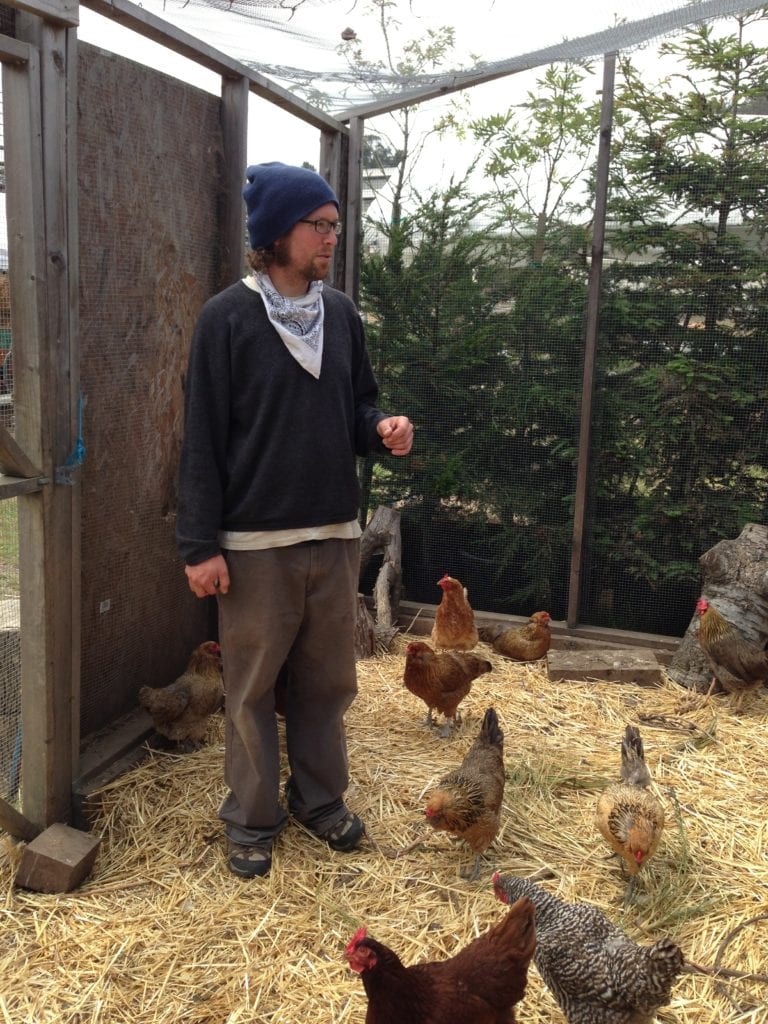
“These hens eat like queens,” said Wentworth-Thrasher, who works part time at SFSU managing new projects in appropriate technology and increasing biodiversity through native habitat landscaping.
The eggs don’t go to waste. Each Monday after school is dismissed ECOSF interns from as close as SFSU and as far as Montreal sell them in the school’s O’Shaughnessy Boulevard parking lot, a sort of mini-Farmer’s Market.
“We’re a bit of a General Store,” said Wentworth-Thrasher. “The sale of the eggs plus vegetables, honey, our homemade organic soaps and hand salves helps to cover some of our costs, too.”
Thirsty now, the hens circled a water bucket that Jacobs put down. Marcus Wong, who lives on Valletta Court across O’Shaughnessy, watched. He’s volunteered once a month for a year now, one of some 20-community volunteers who hone their green thumbs each month.
“Walking the canyon one day I saw the farm and scaled a fence,” said Wong, a fraud investigator for an accounting firm. “I returned home and asked my roommate and he said they teach kids there.”
He walked to a bed of quinoa, which the farm is piloting for the Bay Area organic restaurants, picked up a garden hose and began watering.
“It’s amazing. People like me have bought food for 40 years, and now I’m part of growing it,” said the locavore. “I’ve reconnected to where food comes from. It’s not genetically modified, it’s organic, it’s local and it’s safe to eat.”
In the village for a ceremonial presentation honoring Dalere’s Beauty Salon’s 45th anniversary, Supervisor Scott Wiener took time to drive up the hill and pay a visit. Wong looked surprised as he greeted the District 8 representative. Circling the farm, Wong oriented the supervisor, showing him the earthen oven, the chicken coop and the native plant garden.
Wiener was nothing if not impressed.
“It’s a great use of school property,” he said. “Particularly educating kids about farming and sustainable living.”
“We’re certainly emphasizing sustainability,” said Wentworth-Thrasher, sounding every bit like the educator he is. “We’re teaching kids to live in the present without sacrificing a comfortable existence in the future.”
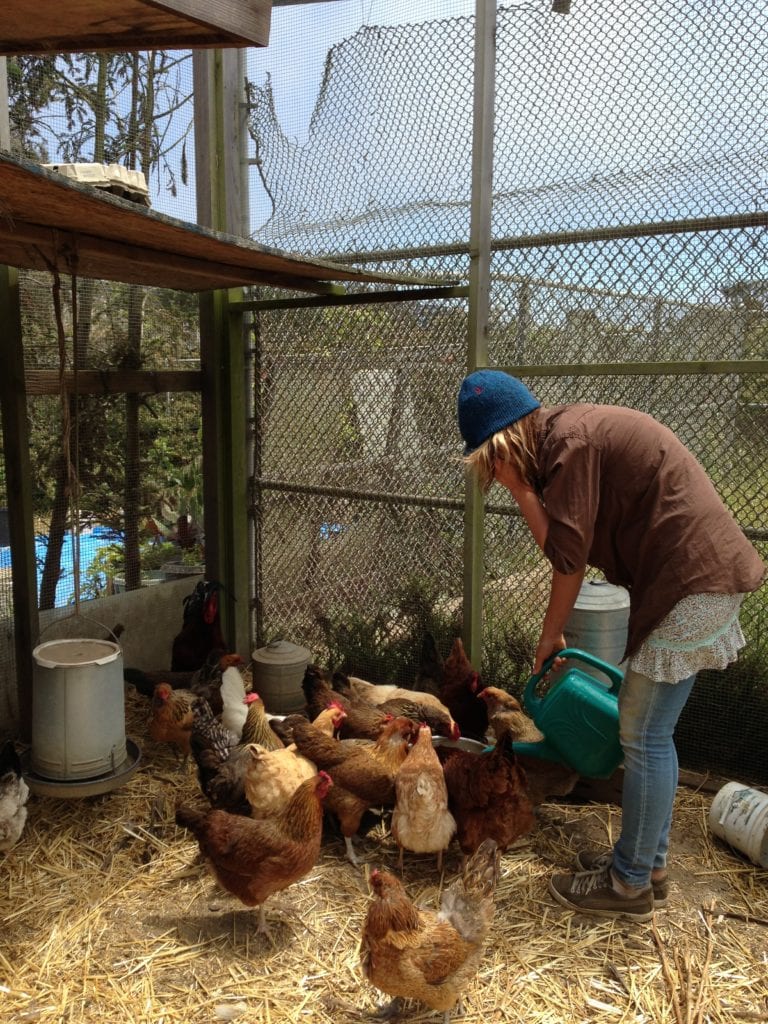
Natori Togawa, an Academy student, joined the group. She’d graduated only a few days earlier. Tanya Garcia, also of the Class of 2013, weighed in, as well.
“It’s our generation that must ensure the environment is working correctly,” said Tanya Garcia, who has been accepted to Humboldt State and intends to study environmental engineering.
“It’s always better to learn from experience,” said Natori, who is scheduled to attend San Francisco State University and study physiology in the fall. “With hands-on experience the eco-system comes alive.”
Earlier in the week, sitting behind his office desk across from Dallman and Wentworth-Thrasher, Academy principal Greg Markwith sounded a lot like the two seniors he’d mentored, who only a day or two before received their diplomas from him as they breezed across the graduation stage.
“It’s all about making connections, connections with a place where food is made and connections with kids,” said Markwith, hobbled with a principal-size school year-ending flu. “It’s equally as important to make cross-curricular connections between our farm and the mathematics, science and English in an endeavor such as this.”
“Like having the kids read Wendell Berry,” Wentworth-Thrasher quickly added, “even someone such as John Jeavons.”
Dallman’s colleague, Kate McGary, an Academy environmental science instructor, brings her students to the farm once a week, and in the afternoon the teens care for the hens and weed the garden beds. Michael Seratan, a Special Education teacher, brings his students to the farm, and they perform similar labors.
“Next year,” Markwith continued, “I want to include ECOSF in our Wednesday afternoon common planning time, which is more important than ever now that Sacramento is rolling out the Common Core Curriculum Standards.”
“Not every student is ready for college,” Wentworth-Thrasher said, watching Markwith reach for a Kleenex box. “But what we’re doing on the farm can give these kids the skills necessary to make the transition.”
“It’s all about relationships,” said Markwith. “I know every kid and I’m not letting any of them fail.”
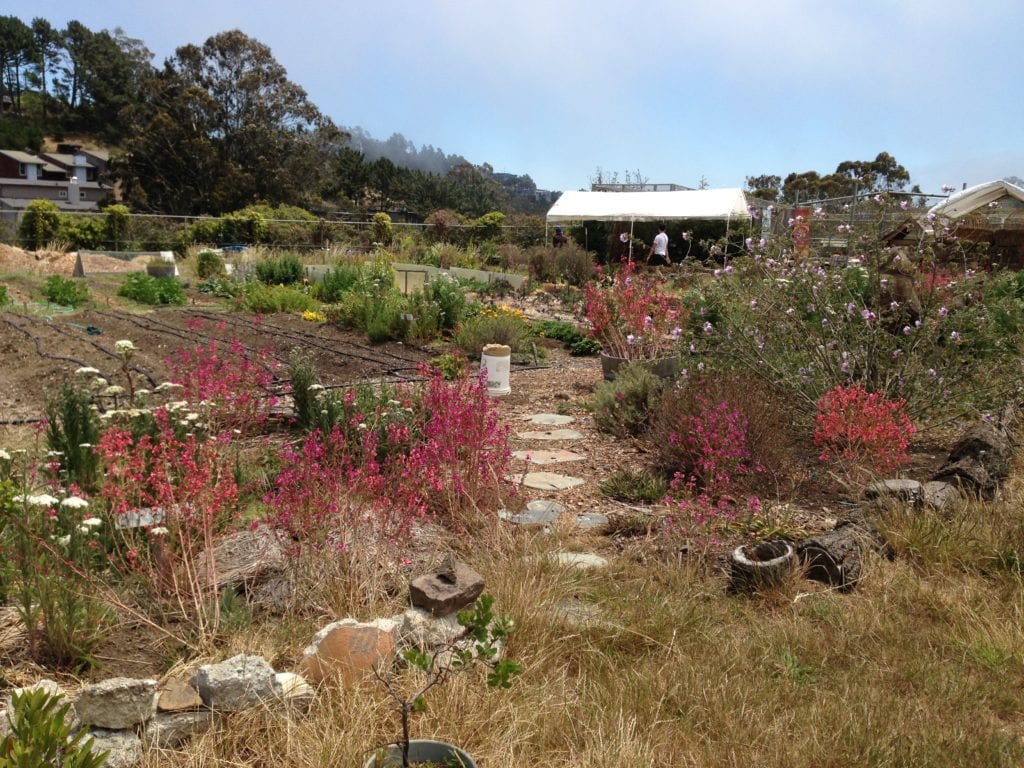
Natori Togawa and Tanya Garcia certainly didn’t. Both spent Academy Thursday afternoons cultivating crops, as well as lopping Himalayan blackberry that encroaches over a school district property trail.
“This trail restoration work is really important,” Natori said, a few days after Markwith had excused himself to drive home and ride out the flu with a mix of yarrow leaf and flower, elderberry and peppermint Wentworth-Thrasher had prepared for him.
“It’s an age old blend that’s used to fight colds,” said Wentworth-Thrasher, who takes the self-sufficiency components of his farmifying to the nth degree. “It’s a mixture anyone can grow or collect from wild sources and make themselves.”
Natori surveyed several rows of raised rectangular plant beds where cabbage, bok choy, carrots, potatoes, squash, watermelon, corn, pumpkins and peas all had grown and had been harvested during her and Tanya’s tenure at the Academy with Tom Dallman.
“We even harvest weeds such as pop seed, crabgrass, ehrharta, and yellow dock and feed them to the hens,” said Wentworth-Thrasher. “But we don’t want to overload the coop because the chickens are already dining well from culled Canyon Market produce.”
“Trail work prevents non-native species from smothering habitat and then canyon animals and insects have lots to eat and can be safe,” said Natori, who, along with Tanya, learned many of her lessons from Natural Areas Program managers who restore and enhance natural areas such as Glen Canyon while developing community-based guardianship of it.
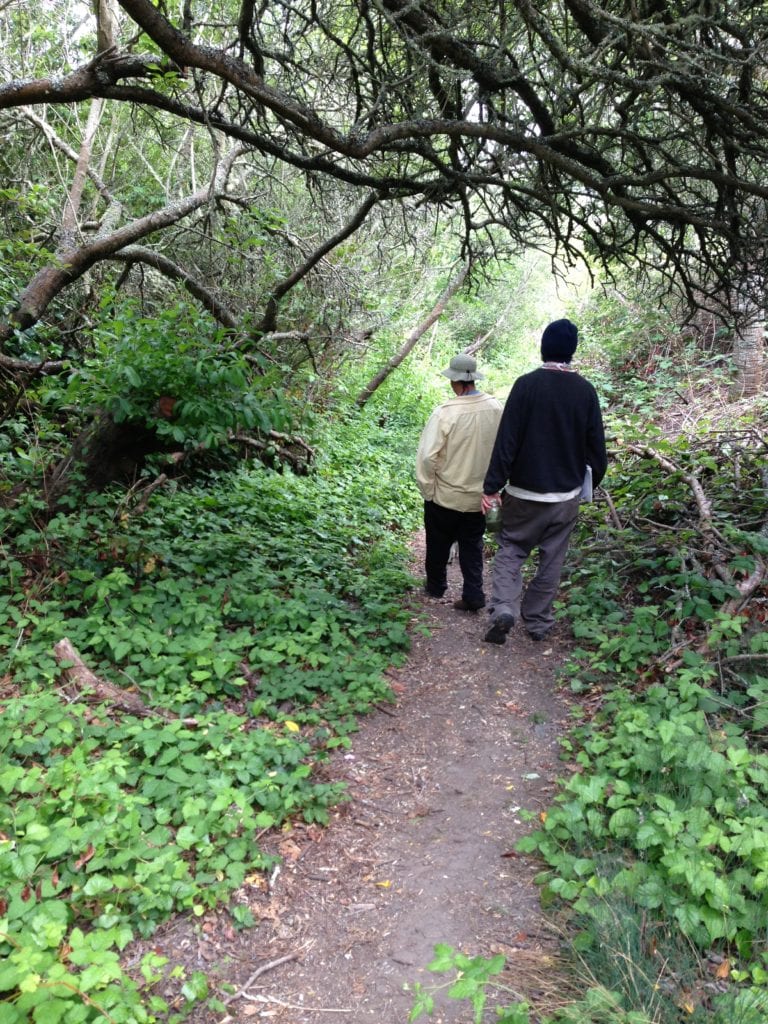
“But we caution the kids not to prune during bird nesting season,” said Dallman, who earned a degree in Biology from the University of California, San Diego and a PhD in Botany from the University of California, Riverside.
Reached later, Lisa Wayne, Natural Areas Program Manager, offered her own thoughts.
“We’re rely on the participation of partners of all ages to care for our natural areas,” Wayne e-mailed. “It’s critically important for Natural Areas Program to provide our young people the experience of the outdoors because by building trails and participating in restoration projects, these youth are learning how to steward our natural areas and are gaining appreciation for nature in the City.”
“I even have this whimsical fantasy that we can restore quail to the canyon,” said Wentworth-Thrasher. “If we model creative stewardship of native habitat, species will return.”
“We’re a city with so little open space,” said Tanya Garcia. “We have to protect it by making sure we manage it.”
Wanting to showcase the student restoration trail work, Tom Dallman walked toward a cyclone fence, trailed by Ella, his three-year old dog. Wentworth-Thrasher followed them to a locked gate, which led to a path paralleling Islais Creek’s headwaters. The rainy season now long over, the noisy creek was silent as the two men closed the gate behind them.
“The kids cleared this trail,” said Dallman, walking beneath a willow-cloaked canopy. “Its taken them four years and its become a wonderful learning space.”
Tanya Garcia, who took Dallman for biology and marine science, treasured the meadow enclave, just off trail.
“I loved the solitude here, surrounded by the sounds of song birds, insects and humming birds,” she said. “I’d write my English A.P. poems here, the ones that had weather and nature themes, and the last book I enjoyed here was In the Time of the Butterflies.”
Beams of sunlight smiled through towering eucalyptus, anointing a pallet of velvety bunch grass that one could imagine as a muse for an adolescent poetess, a secluded sanctuary to pen verse.
“The kids would maneuver through a hole in the fence,” she continued. “We’d come out here every chance we could.”
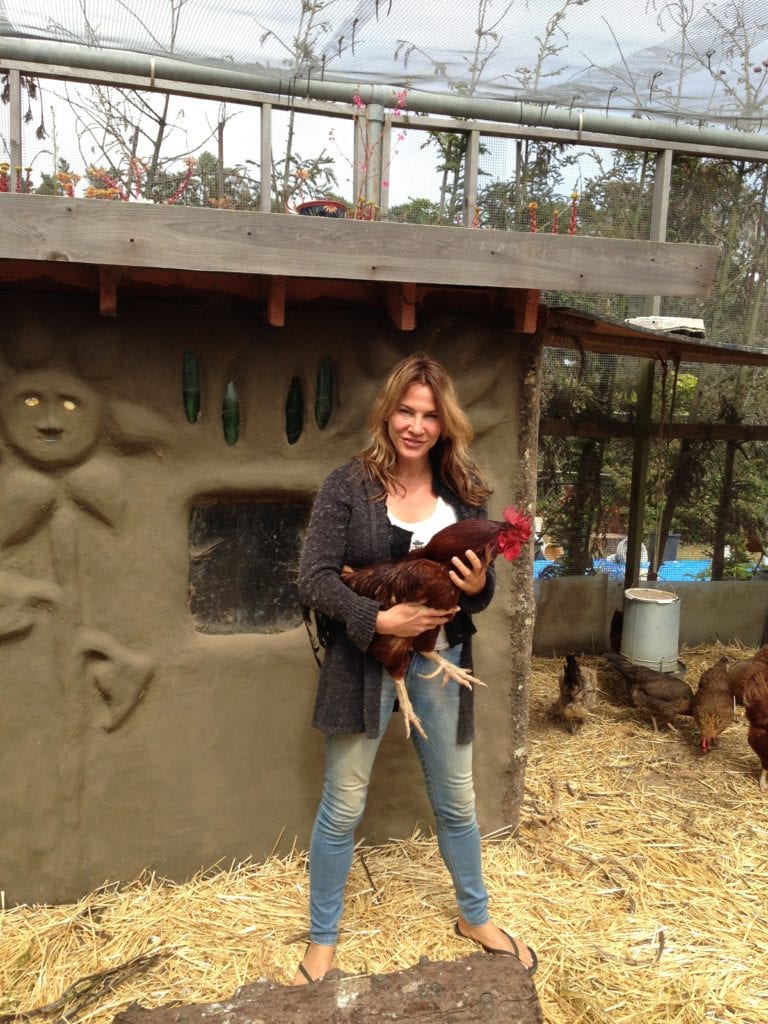
“In my sophomore year at the farm I helped construct the raised plant beds and the compost bins,” said Garcia, who plans to devote post-graduate Saturdays to the farm during college breaks next year. “SOTA kids, the singer songwriters and the poets, joined Saturday work-parties and performed their songs and recited their poems.”
“The veggie pizzas we’d make in the earthen oven after the autumn harvest on these Saturday’s were awesome,” she enthused. “It’s all because of Sam Hartman, who’s amazing. He came to my elementary school ten years ago and turned me on to Glen Canyon.”
Hartman, the first leg of the Wentworth-Thrasher and Jacobs triumvirate, took off for Point Reyes a day or so after school was out.
Dallman and Wentworth-Thrasher continued their hike. Scaly-barked willow hung over the scratched-out trail, but didn’t impede it. Himalayan blackberry thorns poked from behind leaves, perforating gentle cotton balls of lichen. Coastal Live Oak pushed from bushes, competing with eucalyptus leaf detritus suffocating the trail edge.
“Whoever built Diamond Heights,” said Dallman, “knew enough to leave these coastal oaks.”
The men walked until school district property butted up against Rec and Park land. To their left, running perpendicular to where they now stood, a canyon trail weaved by 1960s-constructed houses built on stanchions and then edged to Turquoise Way. To their right another trail ran past reintroduced NAP native shrubbery and continued to a popular rope swing used by Silver Tree Day campers.
With Ella scrambling behind, they retraced their steps to the locked gate. Dallman pointed north to Portola Drive. It couldn’t be seen because invasive Cape ivy and English ivy engulfed the hill, garroting the endangered habitat beneath it.
“With several switchbacks, a connector trail can be built to Portola,” he said. “Then it’ll be possible to walk the length of the canyon down to Elk Street.”
Rec and Park envisions just such a trail, part of what it labels “Peaks to Creek,” a project that will wend its way from Twin Peaks through Glen Canyon.
Rec and Park’s Lisa Wayne weighed in on this, as well:
“We are thrilled. The Peaks to Creeks trail will be a jewel in our park system.”
Some neighbors aren’t pleased, though, convinced any new path will only attract drug deals. Tom Dallman supports the City.
“I think the connector will daylight any activity,” he said, “and bring in ever so many more visitors.”
He stopped and gestured to the school roof, long a victim, like the rest of the building, of deferred maintenance. He pointed to a jigsaw puzzle of irrigation infrastructure snaking from the school.
“That’s where we’ve built a gravity-fed rain collection system so we can have a demonstration rainwater garden,” he said. “All the rubber piping running down to the farm came from a $6,000 National Oceanic Atmospheric Administration grant, which provided lumber, even the loppers the kids used to clear the trail.”
“The plan is to capture rainwater from the main roof and store it in a series of cisterns with a total capacity of 30,000 gallons that will be used for farm irrigation throughout the year,” said Wentworth-Thrasher. “This is a model that homeowners can use in their backyards by simply redirecting the downspout from their roof gutters into their landscaped yards.”
They reentered the farm and eventually stood at a mini-garden of Islais cherry, wild currant, Douglas iris and cow’s parsnip, all habitats that aid the health of bees and birds.
Here they rejoined Tori Jacobs.
Pretty much all of the farm’s operating expenses come from Sam Hartman, Wentworth-Thrasher and Jacob’s own pockets.
“We’re eligible for a $125,000 school district grant for greening school grounds,” said Jacobs. “We make some money designing benches and chairs from sand saw clay, but we all need day jobs. Sam’s a caretaker for AIDS patients and I chauffer a lady.”
Jacobs is an artist, as well. Her sculptures of owls and a coyote stand next to the garden angelica, sticky monkey flower and soap root plants.
“Owls and coyotes live in the canyon,” she said. “I’m working on a red-tailed hawk next, and I hope someday to have replicas of all canyon critters circling the farm.”
Jacobs and Marcus Wong, who’d remained long after Scott Wiener had departed, inched closer to the chicken house. Wong began gathering eggs. Two hens nested in the coop, looking satisfied with themselves. They rested on a wooden roost, the product of their labors boxed in a bucket that Wong held.
Jacobs picked up Jesse James. Razor sharp, his claws looked as if they’d give a good account of themselves if a prowling intruder threatened his harem. Jesse’s comb was bright red, and Jacobs stroked his feathers.
“A while back vandals broke in and one of Jesse’s hens escaped and stayed missing for three days,” said Jacobs. “The school cook found her roaming around the courtyard and brought her back.”
Undoubtedly, Jesse was pleased. But this being a high school, after all, there’s lots of drama when a new lady of any species is introduced to either student body.
“We have a alpha hen. Her name’s Tonto,” said Jacobs. “Tonto didn’t like her new competition. Jesse’s new companions quickly learned to stay near the king of the roost.”
Jacobs smiled at the fine-feathered rogue.
“Jesse James is one happy rooster.”
=====
Anyone interested in finding out more about the Academy student farm, when they can purchase eggs and veggies, can learn more by telephoning principal Greg Markwith at 415-695-5700 or go to ECOSF website or e-mail Davin Wentworth-Thrasher at davin@eco-sf.org. Anyone interested in volunteering for the Rec and Park Natural Areas Program can contact volunteer coordinator Joe Grey at joe.grey@sfgov.org